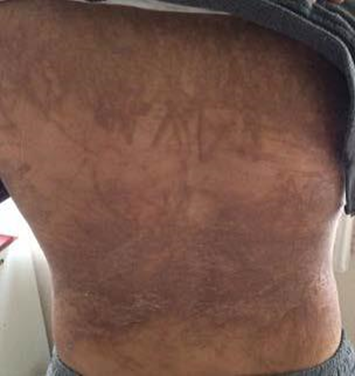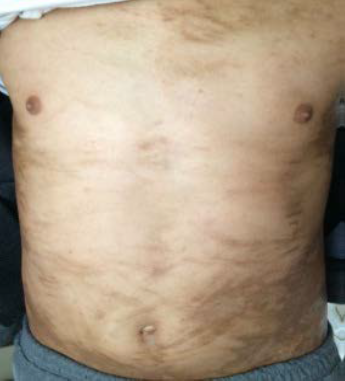Case Report
Flagella Dermatitis is a Rare Skin Lesion due to Bleomycin Use: A Case Report
- Zuhat Urakci 1*
- Yasin Sezgin 2
- Ogur Karhan 3
- Suat Morkuzu 4
- Zeynep Oruc 1
- Mehmet Kucukoner 1
- Muhammet Ali Kaplan 1
- Abdurrahman Isikdogan 1
1.Department of Medical Oncology, Dicle University, Diyarbakir, Turkey.
2.Department of Medical Oncology, Siirt University, Siirt, Turkey.
3.Department of Medical Oncology, Liv Hospital, Gaziantep, Turkey.
4.Institute for Reconstructive Surgery, Houston Methodist Hospital, Houston, Texas, USA.
*Corresponding Author: Zuhat Urakci, Department of Medical Oncology, Dicle University, Diyarbakir, Turkey.
Citation: Urakci Z., Sezgin Y., Karhan O., Morkuzu S., Oruc Z., et al. (2023). Flagella Dermatitis is a Rare Skin Lesion due to Bleomycin Use: A Case Report. International Clinical and Medical Case Reports, BioRes Scientia Publishers. 2(3):1-3. DOI: 10.59657/2837-5998.brs.23.016
Copyright: © 2023 Zuhat Urakci, this is an open-access article distributed under the terms of the Creative
Commons Attribution License, which permits unrestricted use, distribution, and reproduction in any medium,
provided the original author and source are credited.
Received: May 30, 2023 | Accepted: June 15, 2023 | Published: September 20, 2023
Abstract
Flagella dermatitis is a rare skin lesion that appears due to bleomycin use. It is generally seen in itchy and linear styles. Here, we present a case of flagella dermatitis in a male patient who was on bleomycin therapy with a diagnosis of germ cell tumor. When itchy skin lesions develop in patients using bleomycin, it should be kept in mind among the differential diagnoses.
Keywords: flagella dermatitis; bleomycin; germ cell tumor
Introduction
Bleomycin is a glycopeptide-structured cytotoxic drug obtained from Streptomyces verticillus [1]. It is often used in the treatment of some malignant tumors, such as Hodgkin lymphoma, squamous cell carcinoma, and germ cell tumors [1]. While various side effects occur in the gastrointestinal tract, respiratory system, and skin due to bleomycin, general symptoms such as fever and weakness can also be seen. Skin reactions are common side effects and usually occur as a late finding. On the skin, erythema, hyperkeratosis, rash, vesicle, hyperpigmentation, alopecia, and, in rare cases, Flagella dermatitis (FD) can be seen [2]. FD was defined by Moulin et al. in 1970 as linear hyperpigmentation after bleomycin use [1]. Its incidence has been reported to be between 8 and 20% in patients using bleomycin [3]. Here, a case of FD developed in a 21-year-old male patient using bleomycin due to a germ cell tumor is presented.
Case report
A twenty-one-year-old male patient was admitted to our clinic with complaints of shortness of breath and cough that started about 45 days ago. A patient was diagnosed with a mediastinal mass, and a biopsy was performed. The patient, who was reported as a germ cell tumor as a result of a biopsy, was given every 21 days from when bleomycin (30 mg/day, 1, 8 and 15 days), etoposide (100 mg / m2, 1-5 days) and cisplatin (20 mg / m2, 1-5 days), was started. In our patient, hyperpigmented skin lesions that developed with itching, mostly in the chest, abdomen, and back, developed after the 2nd dose of bleomycin (Figure 1 & 2). Due to the development of the lesions after bleomycin, and in a linear style, FD was considered in our patient. The patient was given oral antihistamine therapy. The dexamethasone that was given before each chemotherapy cycle was continued. During the follow-up, the patient's itching passed and the skin lesions regressed. The patient's bleomycin treatment was continued, and there was no itching again.
Figure 1: Hyperpigmented skin lesions with diffuse linear style on the back.
Figure 2: Hyperpigmented skin lesions in the abdominal and chest with diffuse linear style.
Discussion
The term "Flagella dermatitis" is used because the hyperpigmented eruptions on the body appear to be whipped [4]. In the case of HIV infection, FD may also develop after the consumption of some poisonous mushrooms or after the use of certain chemo-therapeutic agents such as peplomycin and docetaxel [5]. Bleomycin is an anti-neoplastic drug belonging to the group of glycopeptides, and bleomycin is destroyed by hydrolase. The concentration of the bleomycin hydrolase enzyme is significantly lower in the skin and lungs. Therefore, the accumulation of bleomycin in the skin and lungs is higher and related toxicities develop. Generally, when the cumulative dose reaches 90-285 mg, bleomycin toxicity begins to occur. However, in some cases, it has been reported that toxicity develops at as low as 15 mg intravenously [6]. Multiple lesions occur suddenly in many parts of the body. Generally, it develops between the 1st and 9th weeks of bleomycin treatment, but this period may take up to 6 months [7]. In our case, FD developed at week 4.
Although FD can rarely be asymptomatic, it usually progresses with itching, redness, and darkening of the skin. Indeed, in our case, there was severe itching, redness, and hyperpigmentation of the skin. The diagnosis is made according to the characteristic features of the skin lesions. Linear-style eruptions occur as if they were whipped, characteristically on the skin. The lesions are itchy and usually occur on the upper body and extremities [8]. Linear hyperpigmented skin lesions are generally localized in areas where itching and pressure are applied [9]. The development mechanism of FD is not known precisely. However, it has been suggested that locally increased melano-genesis, insufficient pigmentation secondary to inflame-mation, change in normal pigmentation pattern, and neutrophilic eccrine hydradenitis can be caused [10]. Patients usually benefit from cortico-steroids and anti-histaminics used in treatment. It reduces itching and limits the lesions to the skin. These lesions usually limit themselves after 3-4 months of discontinuation and begin to regress and disappear after 6-8 months. However, after the use of bleomycin again, the lesions may reappear [11]. In our case, corticosteroid and anti-histaminic therapy completely alleviated the symptoms.
Conclusion
When itchy lesions develop in patients using bleomycin, FD should be kept in mind among the differential diagnoses, and physicians should be careful about the toxicity of bleomycin.
Conflict of interest
The authors declared that there is no conflict of interest.
References
- Grynszpan R, Niemeyer-Corbellini JP, Lopes MSS, et al (2013). Bleomycin-induced flagellate dermatitis. BMJ Case Rep.
Publisher | Google Scholor - Solimando Jr DA. (2008). Drug information handbook for oncology. 7th ed. Canada: Lexi-Comp. p.147.
Publisher | Google Scholor - Jonathan Stevens G.a, María Teresa Dossi C.b, Gianna Muñoz M.c. (2018). Bleomycin-induced Flagellated dermatitis: a case report, Rev Chil Pediatr. 89(2):257-60.
Publisher | Google Scholor - Mota GD, Penna AM, Soares RC, Baiocchi OC. (2014). Bleomycin-induced flagellate dermatitis. Rev Bras Hematol 36:297-9.
Publisher | Google Scholor - Bhushan P, Manjul P, Baliyan V. (2014). Flagellate dermatoses. Indian J Dermatol Venereol Leprol. 80:149-52.
Publisher | Google Scholor - Lee HY, Lim KH, Ryu Y, Song SY. (2014). Bleomycin-induced flagellate erythema: A case report. Oncol Lett 8:933-5.
Publisher | Google Scholor - Pavithran K, Do DC, Talwar V Vaid AK. (2004). Flagellate hyperpigmentation from bleomycin. Indian J Dermatol Venereol Leprol 70:46-7.
Publisher | Google Scholor - Biswas A, Chaudhari PB, Sharma P et al. (2013). Bleomycin induced flagellate erythema: Revisiting a unique complication. J Cancer Res Ther. 9(3):500-3.
Publisher | Google Scholor - Nayak N, Friedmann PS, Healy E. (2003). Bleomycin induced flagellate dermatosis. Clin Exp Dermatol. 28 (1):105-6.
Publisher | Google Scholor - Al-khenaızan S, Al-berouti B. Flagellate pigmentation: a unique adverse effect of bleomycin therapy. EJD. 21(1);146.
Publisher | Google Scholor - Simpson RC, Da P, Nagarajan C, Harman KE. (2011). A pruritic rash in a patient with Hodgkin lymphoma. Clin Exp Dermatol 36:680-2.
Publisher | Google Scholor
















